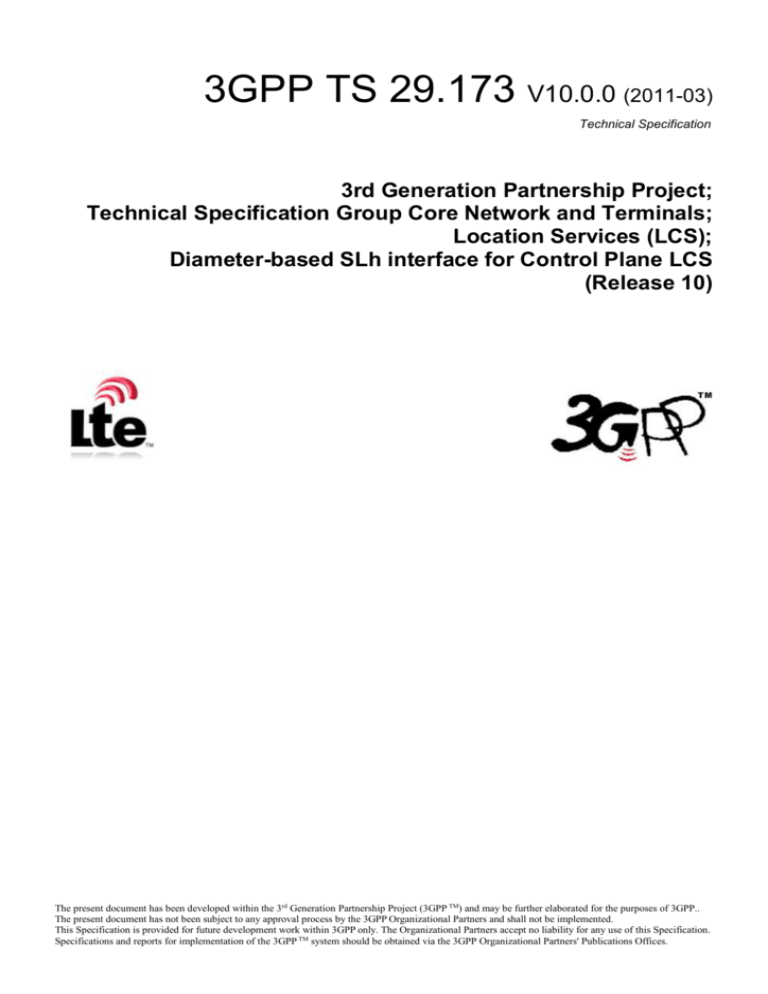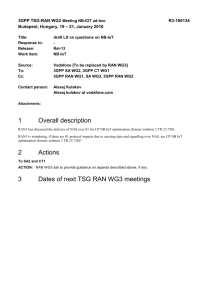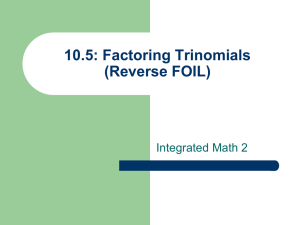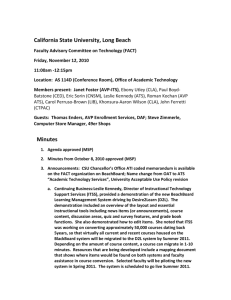
3GPP TS 29.173 V10.0.0 (2011-03)
Technical Specification
3rd Generation Partnership Project;
Technical Specification Group Core Network and Terminals;
Location Services (LCS);
Diameter-based SLh interface for Control Plane LCS
(Release 10)
The present document has been developed within the 3rd Generation Partnership Project (3GPP TM) and may be further elaborated for the purposes of 3GPP..
The present document has not been subject to any approval process by the 3GPP Organizational Partners and shall not be implemented.
This Specification is provided for future development work within 3GPP only. The Organizational Partners accept no liability for any use of this Specification.
Specifications and reports for implementation of the 3GPP TM system should be obtained via the 3GPP Organizational Partners' Publications Offices.
Release 10
2
3GPP TS 29.173 V10.0.0 (2011-03)
Keywords
LTE, LCS, SLh interface, Diameter
3GPP
Postal address
3GPP support office address
650 Route des Lucioles - Sophia Antipolis
Valbonne - FRANCE
Tel.: +33 4 92 94 42 00 Fax: +33 4 93 65 47 16
Internet
http://www.3gpp.org
Copyright Notification
No part may be reproduced except as authorized by written permission.
The copyright and the foregoing restriction extend to reproduction in all media.
© 2011, 3GPP Organizational Partners (ARIB, ATIS, CCSA, ETSI, TTA, TTC).
All rights reserved.
UMTS™ is a Trade Mark of ETSI registered for the benefit of its members
3GPP™ is a Trade Mark of ETSI registered for the benefit of its Members and of the 3GPP Organizational Partners
LTE™ is a Trade Mark of ETSI currently being registered for the benefit of its Members and of the 3GPP Organizational Partners
GSM® and the GSM logo are registered and owned by the GSM Association
3GPP
Release 10
3
3GPP TS 29.173 V10.0.0 (2011-03)
Contents
Foreword............................................................................................................................................................. 5
1
Scope ........................................................................................................................................................ 6
2
References ................................................................................................................................................ 6
3
Definitions, symbols and abbreviations ................................................................................................... 7
3.1
3.2
4
4.1
4.2
4.3
5
5.1
5.2
5.2.1
5.2.1.1
5.2.1.2
5.2.1.3
6
6.1
6.1.1
6.1.2
6.1.3
6.1.4
6.1.5
6.1.6
6.1.7
6.1.8
6.1.9
6.2
6.2.1
6.2.2
6.2.3
6.2.4
6.3
6.3.1
6.3.2
6.3.3
6.3.3.1
6.3.3.2
6.3.4
6.3.4.1
6.4
6.4.1
6.4.2
6.4.3
6.4.4
6.4.5
6.4.6
6.4.7
6.4.8
6.4.9
6.4.10
6.4.11
Definitions ......................................................................................................................................................... 7
Abbreviations ..................................................................................................................................................... 7
General Description.................................................................................................................................. 7
Introduction........................................................................................................................................................ 7
Architecture Overview ....................................................................................................................................... 7
Functional Requirements of SLh Interface ........................................................................................................ 8
Diameter-based SLh Interface .................................................................................................................. 8
Introduction........................................................................................................................................................ 8
Procedure Descriptions ...................................................................................................................................... 8
Send Routing Information for LCS .............................................................................................................. 8
General ................................................................................................................................................... 8
Detailed Behaviour of the HSS............................................................................................................... 9
Detailed Behaviour of the GLMC ........................................................................................................ 10
Protocol Specification and Implementations .......................................................................................... 10
Introduction...................................................................................................................................................... 10
Use of Diameter Base Protocol .................................................................................................................. 10
Securing Diameter Messages ..................................................................................................................... 10
Accounting Functionality ........................................................................................................................... 10
Use of Sessions .......................................................................................................................................... 10
Transport Protocol ...................................................................................................................................... 11
Routing Considerations .............................................................................................................................. 11
Advertising Application Support................................................................................................................ 11
Diameter Application Identifier ................................................................................................................. 11
User Identity to HSS resolution.................................................................................................................. 11
Commands ....................................................................................................................................................... 12
Introduction ................................................................................................................................................ 12
Command-Code values .............................................................................................................................. 12
LCS-Routing-Info-Request (RIR) Command ............................................................................................ 12
LCS-Routing-Info-Answer (RIA) Command ............................................................................................. 13
Result-Code AVP and Experimental-Result AVP Values ............................................................................... 13
General ....................................................................................................................................................... 13
Success ....................................................................................................................................................... 13
Permanent Failures ..................................................................................................................................... 13
DIAMETER_ERROR_USER_UNKNOWN (5001)............................................................................ 14
DIAMETER_ERROR_UNAUTHORIZED_REQUESTING_NETWORK (5490) ............................. 14
Transient Failures ...................................................................................................................................... 14
DIAMETER_ERROR_ABSENT_USER (4201) ................................................................................. 14
AVPs ................................................................................................................................................................ 14
General ....................................................................................................................................................... 14
LMSI .......................................................................................................................................................... 15
Serving-Node ............................................................................................................................................. 15
MME-Name ............................................................................................................................................... 15
MSC-Number ............................................................................................................................................. 15
LCS-Capabilities-Sets ................................................................................................................................ 15
GMLC-Address .......................................................................................................................................... 16
Additional-Serving-Node ........................................................................................................................... 16
PPR-Address .............................................................................................................................................. 16
Feature-List-ID AVP .................................................................................................................................. 16
Feature-List AVP ....................................................................................................................................... 16
3GPP
Release 10
Annex A (informative):
4
3GPP TS 29.173 V10.0.0 (2011-03)
Change history ............................................................................................... 17
3GPP
Release 10
5
3GPP TS 29.173 V10.0.0 (2011-03)
Foreword
This Technical Specification has been produced by the 3 rd Generation Partnership Project (3GPP).
The contents of the present document are subject to continuing work within the TSG and may change following formal
TSG approval. Should the TSG modify the contents of the present document, it will be re-released by the TSG with an
identifying change of release date and an increase in version number as follows:
Version x.y.z
where:
x the first digit:
1 presented to TSG for information;
2 presented to TSG for approval;
3 or greater indicates TSG approved document under change control.
y the second digit is incremented for all changes of substance, i.e. technical enhancements, corrections,
updates, etc.
z the third digit is incremented when editorial only changes have been incorporated in the document.
3GPP
Release 10
1
6
3GPP TS 29.173 V10.0.0 (2011-03)
Scope
The present document describes the Diameter-based SLh interface between the GMLC and the HSS defined for the
Control Plane LCS in EPC.
LCS procedures over the SLh interface are defined in the 3GPP TS 23.271 [2].
This specification defines the Diameter application for the GMLC-HSS, SLh reference point. The interactions between
the HSS and the GMLC are specified, including the signalling flows. As LCS procedures over the Diameter-based SLh
interface are identical to the MAP-based Lh interface, the descriptions of the Lh MAP operations defined in the 3GPP
TS 29.002 [3] are mapped into the descriptions of the SLh Diameter commands.
2
References
The following documents contain provisions which, through reference in this text, constitute provisions of the present
document.
-
References are either specific (identified by date of publication, edition number, version number, etc.) or
non-specific.
-
For a specific reference, subsequent revisions do not apply.
-
For a non-specific reference, the latest version applies. In the case of a reference to a 3GPP document (including
a GSM document), a non-specific reference implicitly refers to the latest version of that document in the same
Release as the present document.
[1]
3GPP TR 21.905: "Vocabulary for 3GPP Specifications".
[2]
3GPP TS 23.271: "Functional stage 2 description of Location Services (LCS)".
[3]
3GPP TS 29.002: "Mobile Application Part (MAP) specification".
[4]
3GPP TS 29.228: "IP multimedia (IM) Subsystem Cx Interface; Signalling flows and Message
Elements".
[5]
IETF RFC 3588: "Diameter Base Protocol".
[6]
3GPP TS 33.210: "3G security; Network Domain Security (NDS); IP network layer security".
[7]
IETF RFC 4960: "Stream Control Transport Protocol".
[8]
3GPP TS 29.229: "Cx and Dx Interfaces based on the Diameter protocol; protocol details".
[9]
3GPP TS 29.329: "Sh Interface based on the Diameter protocol; protocol details".
[10]
3GPP TS 23.003: "Numbering, addressing and identification ".
[11]
3GPP TS 23.012: "Location Management Procedures".
[12]
3GPP TS 29.272: "Mobility Management Entity (MME) and Serving GPRS Support Node
(SGSN) related interfaces based on Diameter protocol".
[13]
IETF RFC 2234: "Augmented BNF for syntax specifications".
[14]
3GPP TS 29.234: "3GPP system to Wireless Local Area Network (WLAN) Interworking;
Stage 3".
3GPP
Release 10
7
3GPP TS 29.173 V10.0.0 (2011-03)
3
Definitions, symbols and abbreviations
3.1
Definitions
For the purposes of the present document, the terms and definitions given in 3GPP TR 21.905 [1], 3GPP TS 23.271 [2]
and the following apply. A term defined in the present document takes precedence over the definition of the same term,
if any, in TR 21.905 [1].
3.2
Abbreviations
For the purposes of the present document, the abbreviations given in 3GPP TR 21.905 [1] and the following apply. An
abbreviation defined in the present document takes precedence over the definition of the same abbreviation, if any, in
3GPP TR 21.905 [1].
ABNF
AVP
H-GMLC
IANA
PMD
PPR
R-GMLC
RFC
V-GMLC
Augmented Backus-Naur form
Attribute Value Pair
Home-Gateway Mobile Location Centre
Internet Assigned Numbers Authority
Pseudonym mediation device functionality
Privacy Profile Register
Requesting-Gateway Mobile Location Centre
Request For Comments
Visited-Gateway Mobile Location Centre
4
General Description
4.1
Introduction
The SLh reference point between the GMLC and the HSS is defined in the 3GPP TS 23.271 [2].
This document describes the Diameter-based SLh interface related procedures, message parameters and protocol
specifications.
4.2
Architecture Overview
The architecture for support of Location Services in GSM, UMTS and EPS has been defined in 3GPP TS 23.271 [2]
and the relevant network elements and interfaces are shown in the figure 4.2-1.
3GPP
Release 10
3GPP TS 29.173 V10.0.0 (2011-03)
8
HSS
SLh
GMLC
Le
External
LCS Client
SLg
MME
Lg
SGSN
Lg
Lpp
MSC/
MSC Server
Lid
PPR
La
PMD
AAA
Server
Figure 4.2-1: Overview of the LCS Functional Architecture
In this architecture, the SLh interface is defined between the Gateway Mobile Location Center (GMLC) and the Home
Subscriber Server (HSS) to allow the GMLC to request routing information from the HLR or HSS.
4.3
Functional Requirements of SLh Interface
The requirements for SLh interface are defined in 3GPP TS 23.271 [2].
The SLh interface is used by the GMLC to request routing information from the HSS i.e. the address of the H-GMLC,
and/or the address of the visited MSC/MSC server, SGSN, 3GPP AAA server or MME for a particular target UE whose
location has been requested.
5
Diameter-based SLh Interface
5.1
Introduction
This section describes the Diameter-based SLh interface related procedures and Information elements exchanged
between functional entities.
In the tables that describe the Information Elements transported by each Diameter command, each Information Element
is marked as (M) Mandatory, (C) Conditional or (O) Optional in the "Cat." column. For the correct handling of the
Information Element according to the category type, see the description detailed in section 6 of the 3GPP TS 29.228 [4].
5.2
Procedure Descriptions
5.2.1
Send Routing Information for LCS
5.2.1.1
General
This procedure is used between the GMLC and the HSS. The procedure is invoked by the GMLC and is used:
-
To retrieve routing information for LCS for a specified user from the HSS.
3GPP
Release 10
9
3GPP TS 29.173 V10.0.0 (2011-03)
This procedure is mapped to the commands LCS-Routing-Info-Request/Answer in the Diameter application specified in
chapter 6. Tables 5.2.1.1/1 and 5.2.1.1/2 detail the involved information elements.
Table 5.2.1.1/1: Send Routing Information for LCS (SLh-LCS-SRI)
Information
element name
Mapping to
Diameter AVP
Cat.
Description
IMSI
User-Name
C
MSISDN
MSISDN
C
GMLC Number
GMLC-Number
O
Supported Features
(See 3GPP TS
29.229 [8])
Supported-Features
O
This information element shall contain the IMSI of the targeted
user. This IE shall be present if the MSISDN is absent.
This information element shall contain the MSISDN of the
targeted user. This IE shall be present if the IMSI is absent.
This information element shall contain the ISDN (E.164) number
of the requesting GMLC.
If present, this information element shall contain the list of
features supported by the origin host.
Table 5.2.1.1/2: Send Routing Information for LCS (SLh-LCS-SRI) Resp
Information
element
name
Mapping to
Diameter AVP
Cat.
Description
Result
(See 5.3.5)
Result-Code /
ExperimentalResult
M
IMSI
User-Name
C
MSISDN
MSISDN
C
LMSI
LMSI
C
Serving Node
Serving-Node
C
Additional
Serving Node
AdditionalServing-Node
C
Home GMLC
Address
PPR Address
GMLC-Address
C
PPR-Address
C
Supported
Features
(See 3GPP TS
29.229 [8])
SupportedFeatures
O
Result of the request.
Result-Code AVP shall be used for errors defined in the Diameter Base
Protocol.
Experimental-Result AVP shall be used for SLh errors. This is a grouped
AVP which contains the 3GPP Vendor ID in the Vendor-Id AVP, and the
error code in the Experimental-Result-Code AVP.
This information element shall contain the IMSI of the targeted user. This
IE shall be present if the MSISDN is absent.
This information element shall contain the MSISDN of the targeted user.
This IE shall be present if the IMSI is absent.
This information element shall contain the LMSI allocated by the VLR. If
available in the HSS, this IE shall be present only when the Result- Code is
DIAMETER_SUCCESS and the serving node is a VLR.
This information element shall contain the information about the network
node serving the targeted user i.e. the name/number of the serving node
(MME, SGSN, 3GPP AAA server or MSC/MSC server), the LCS
capabilities sets supported by the serving node and the IP address of the
visited GMLC associated with the serving node. This IE shall be present
only when the Result- Code is DIAMETER_SUCCESS.
This information element shall contain the information about another
network node serving the targeted user. This IE shall be present only when
the Result- Code is DIAMETER_SUCCESS. There may be multiple
instances of this IE in the response provided by the HSS.
This information element shall contain the IP address of the H-GMLC. This
IE shall be present only when the Result-Code is DIAMETER_SUCCESS.
This information element shall contain the IP address of the Privacy Profile
Register (PPR). If available in the HSS, this IE shall be present only when
the Result-Code is DIAMETER_SUCCESS.
If present, this information element shall contain the list of features
supported by the origin host.
5.2.1.2
Detailed Behaviour of the HSS
Upon reception of the Send Routing Info for LCS request, the HSS shall, in the following order:
3GPP
Release 10
10
3GPP TS 29.173 V10.0.0 (2011-03)
1. Check whether the requesting GMLC belongs to a network authorized to request UE location information. If not,
Experimental-Result shall be set to DIAMETER_ERROR_UNAUTHORIZED_REQUESTING_NETWORK in
the Send Routing Information for LCS Response.
2. Check that the User Identity for whom data is asked exists in HSS. If not, Experimental-Result shall be set to
DIAMETER_ERROR_USER_UNKNOWN in the Send Routing Information for LCS Response.
3. Check that there is serving node associated with the targeted user. If not, Experimental-Result shall be set to
DIAMETER_ERROR_ABSENT_USER in the Send Routing Information for LCS Response.
If there is an error in any of the above steps then the HSS shall stop processing and shall return the error code specified
in the respective step (see 3GPP TS 29.329 [9] and 3GPP TS 29.229 [8] for an explanation of the error codes).
If the HSS cannot fulfil the received request for reasons not stated in the above steps, e.g. due to a database error or
empty mandatory data elements, it shall stop processing the request and set Result-Code to
DIAMETER_UNABLE_TO_COMPLY.
Otherwise, the requested operation shall take place and the HSS shall return the Result-Code AVP set to
DIAMETER_SUCCESS. The HSS returns one or several of the network addresses of the current MME, SGSN,
3GPP AAA server and/or VMSC/MSC server, the LCS capabilities of the serving nodes if available, the V-GMLC
address associated with the serving nodes, if available, and whichever of the IMSI and MSISDN that was not provided
in the Send Routing Info for LCS request. The HSS returns the address of the H-GMLC. The HSS also provides the
address of the PPR, if available.
5.2.1.3
Detailed Behaviour of the GLMC
If there are a serving node as well as additional serving nodes in a successful Send Routing Info for LCS response, the
receiving shall use the serving node in preference to the additional serving nodes.
6
Protocol Specification and Implementations
6.1
Introduction
6.1.1
Use of Diameter Base Protocol
The Diameter Base Protocol as specified in IETF RFC 3588 [5] shall apply except as modified by the defined support
of the methods and the defined support of the commands and AVPs, result and error codes as specified in this
specification. Unless otherwise specified, the procedures (including error handling and unrecognised information
handling) shall be used unmodified.
6.1.2
Securing Diameter Messages
For secure transport of Diameter messages, see 3GPP TS 33.210 [6].
6.1.3
Accounting Functionality
Accounting functionality (Accounting Session State Machine, related command codes and AVPs) shall not be used on
the SLh interface.
6.1.4
Use of Sessions
Between the GMLC and the HSS, Diameter sessions shall be implicitly terminated. An implicitly terminated session is
one for which the server does not maintain state information. The client shall not send any re-authorization or session
termination requests to the server.
The Diameter base protocol includes the Auth-Session-State AVP as the mechanism for the implementation of
implicitly terminated sessions.
3GPP
Release 10
11
3GPP TS 29.173 V10.0.0 (2011-03)
The client (server) shall include in its requests (responses) the Auth-Session-State AVP set to the value
NO_STATE_MAINTAINED (1), as described in IETF RFC 3588 [5]. As a consequence, the server shall not maintain
any state information about this session and the client shall not send any session termination request. Neither the
Authorization-Lifetime AVP nor the Session-Timeout AVP shall be present in requests or responses.
6.1.5
Transport Protocol
Diameter messages over the SLh interface shall make use of SCTP IETF RFC 4960 [7] as transport protocol.
6.1.6
Routing Considerations
This clause specifies the use of the Diameter routing AVPs Destination-Realm and Destination-Host.
If GMLC knows the address/name of the HSS for a certain user, both the Destination-Realm AVP and the DestinationHost AVP shall be present in the request. Otherwise, only the Destination-Realm AVP shall be present and the
command shall be routed to the next Diameter node. Consequently, the Destination-Host AVP is declared as optional in
the ABNF for all requests initiated by a GMLC.
Destination-Realm AVP is declared as mandatory in the ABNF for all requests.
6.1.7
Advertising Application Support
The HSS and GMLC shall advertise support of the Diameter SLh Application by including the value of the application
identifier in the Auth-Application-Id AVP within the Vendor-Specific-Application-Id grouped AVP of the CapabilitiesExchange-Request and Capabilities-Exchange-Answer commands.
The vendor identifier value of 3GPP (10415) shall be included in the Supported-Vendor-Id AVP of the CapabilitiesExchange-Request and Capabilities-Exchange-Answer commands, and in the Vendor-Id AVP within the VendorSpecific-Application-Id grouped AVP of the Capabilities-Exchange-Request and Capabilities-Exchange-Answer
commands.
The Vendor-Id AVP included in Capabilities-Exchange-Request and Capabilities-Exchange-Answer commands that is
not included in the Vendor-Specific-Application-Id AVPs as described above shall indicate the manufacturer of the
Diameter node as per RFC 3588 [5].
6.1.8
Diameter Application Identifier
The SLh interface protocol shall be defined as an IETF vendor specific Diameter application, where the vendor is
3GPP. The vendor identifier assigned by IANA to 3GPP (http://www.iana.org/assignments/enterprise-numbers) is
10415.
The Diameter application identifier assigned to the SLh interface application is 16777291 (allocated by IANA).
6.1.9
User Identity to HSS resolution
The User identity to HSS resolution mechanism enables the GMLC (for non-roaming case) or Diameter Relay/proxy
agents in the home network (for roaming case) to find the identity of the HSS that holds the LCS subscription data and
routing information for the target user when multiple and separately addressable HSSs have been deployed in the home
network. The resolution mechanism is not required in networks that utilise a single HSS.
This User identity to HSS resolution mechanism may rely on routing capabilities provided by Diameter and be
implemented in the home operator network within dedicated Diameter Agents (Redirect Agents or Proxy Agents)
responsible for determining the HSS identity based on the provided user identity. If this Diameter based implementation
is selected by the Home network operator, the principles described in the 3GPP TS 29.272 [12] shall apply.
NOTE:
Alternatives to the user identity to HSS resolution Diameter based implementation are outside the scope
of this specification.
3GPP
Release 10
3GPP TS 29.173 V10.0.0 (2011-03)
12
6.2
Commands
6.2.1
Introduction
This section defines the Command code values and related ABNF for each command described in this specification.
6.2.2
Command-Code values
This section defines Command-Code values for the SLh interface application as allocated by IANA.
Every command is defined by means of the ABNF syntax IETF RFC 2234 [13], according to the rules in IETF RFC
3588 [5]. In the case, the definition and use of an AVP is not specified in this document, the guidelines in IETF RFC
3588 [5] shall apply.
The following Command Codes are defined in this specification:
Table 6.2.2/1: Command-Code values for SLh
Command-Name
Abbreviatio
n
Code
Section
LCS-Routing-Info-Request
LCS-Routing-Info-Answer
RIR
RIA
8388622
8388622
6.2.3
6.2.4
For these commands, the Application-ID field shall be set to 16777291 (application identifier of the SLh interface
application, allocated by IANA).
6.2.3
LCS-Routing-Info-Request (RIR) Command
The LCS-Routing-Info-Request (RIR) command, indicated by the Command-Code field set to 8388622 and the "R" bit
set in the Command Flags field, is sent from GMLC to HSS.
Message Format
< LCS-Routing-Info-Request> ::= < Diameter Header: 8388622, REQ, PXY, 16777291 >
< Session-Id >
{ Auth-Session-State }
{ Origin-Host }
{ Origin-Realm }
[ Destination-Host ]
{ Destination-Realm }
[ User-Name ]
[ MSISDN ]
[ GMLC-Number ]
*[ Supported-Features ]
*[ Proxy-Info ]
*[ Route-Record ]
*[ AVP ]
3GPP
Release 10
6.2.4
13
3GPP TS 29.173 V10.0.0 (2011-03)
LCS-Routing-Info-Answer (RIA) Command
The LCS-Routing-Info-Answer (RIA) command, indicated by the Command-Code field set to 8388622 and the 'R' bit
cleared in the Command Flags field, is sent from HSS to GMLC.
Message Format
< LCS-Routing-Info-Answer> ::= < Diameter Header: 8388622, PXY, 16777291 >
< Session-Id >
[ Result-Code ]
[ Experimental-Result ]
{ Auth-Session-State }
{ Origin-Host }
{ Origin-Realm }
*[ Supported-Features ]
[ User-Name ]
[ MSISDN ]
[ LMSI ]
[ Serving-Node ]
*[ Additional-Serving-Node ]
[ GMLC-Address ]
[ PPR-Address ]
*[ AVP ]
*[ Failed-AVP ]
*[ Proxy-Info ]
*[ Route-Record ]
6.3
Result-Code AVP and Experimental-Result AVP Values
6.3.1
General
This section defines result code values that shall be supported by all Diameter implementations that conform to this
specification.
6.3.2
Success
Result codes that fall within the Success category shall be used to inform a peer that a request has been successfully
completed. The Result-Code AVP values defined in Diameter Base Protocol RFC 3588 [5] shall be applied.
6.3.3
Permanent Failures
Errors that fall within the Permanent Failures category shall be used to inform the peer that the request has failed, and
should not be attempted again. The Result-Code AVP values defined in Diameter Base Protocol RFC 3588 [5] shall be
applied. When one of the result codes defined here is included in a response, it shall be inside an Experimental-Result
AVP and the Result-Code AVP shall be absent.
3GPP
Release 10
6.3.3.1
3GPP TS 29.173 V10.0.0 (2011-03)
14
DIAMETER_ERROR_USER_UNKNOWN (5001)
This result code shall be sent by the HSS to indicate that the user identified by the IMSI or the MSISDN is unknown.
This error code is defined in 3GPP TS 29.229 [8]
6.3.3.2
DIAMETER_ERROR_UNAUTHORIZED_REQUESTING_NETWORK (5490)
This result code shall be sent by the HSS to indicate that the requesting GMLC's network is not authorized to request
UE location information.
6.3.4
Transient Failures
Errors that fall within the transient failures category are those used to inform a peer that the request could not be
satisfied at the time that it was received. The request may be able to be satisfied in the future.
6.3.4.1
DIAMETER_ERROR_ABSENT_USER (4201)
This result code shall be sent by the HSS to indicate that the location of the targeted user is not known at this time to
satisfy the requested operation.
6.4
AVPs
6.4.1
General
The following table specifies the Diameter AVPs defined for the SLh interface protocol, their AVP Code values, types,
possible flag values and whether or not the AVP may be encrypted. The Vendor-ID header of all AVPs defined in this
specification shall be set to 3GPP (10415).
Table 6.4.1/1: SLh specific Diameter AVPs
AVP Flag rules
Attribute Name
AVP
Code
Section
defined
Value Type
Must May
Should
not
Must
not
May
Encr.
LMSI
2400
6.4.2
OctetString
M, V
No
Serving-Node
2401
6.4.3
Grouped
M, V
No
MME-Name
2402
6.4.4
DiameterIdentity
M, V
No
MSC-Number
2403
6.4.5
OctetString
M, V
No
LCS-Capabilities2404
6.4.6
Unsigned32
M, V
No
Sets
GMLC-Address
2405
6.4.7
Address
M, V
No
Additional-Serving- 2406
6.4.8
Grouped
M, V
No
Node
PPR-Address
2407
6.4.9
Address
M, V
No
NOTE 1: The AVP header bit denoted as "M", indicates whether support of the AVP is required. The AVP header bit
denoted as "V", indicates whether the optional Vendor-ID field is present in the AVP header. For further
details, see IETF RFC 3588 [5].
The following table specifies the Diameter AVPs re-used by the SLh interface protocol from existing Diameter
Applications, including a reference to their respective specifications and when needed, a short description of their use
within SLh.
Any other AVPs from existing Diameter Applications, except for the AVPs from Diameter Base Protocol, do not need
to be supported. The AVPs from Diameter Base Protocol are not included in table 6.4.1/2, but they may be re-used for
the SLh protocol.
3GPP
Release 10
15
3GPP TS 29.173 V10.0.0 (2011-03)
Table 6.4.1/2: SLh re-used Diameter AVPs
Attribute Name
Reference
Comments
MSISDN
3GPP TS 29.329 [9]
SGSN-Number
3GPP TS 29.272 [12]
Supported-Features
3GPP TS 29.229 [8]
Feature-List-ID
3GPP TS 29.229 [8] See section 6.4.10
Feature-List
3GPP TS 29.229 [8] See section 6.4.11
GMLC-Number
3GPP TS 29.272 [12]
3GPP-AAA-Server-Name 3GPP TS 29.234 [14]
6.4.2
LMSI
The LMSI AVP is of type OctetString and it shall contain the Local Mobile Station Identity (LMSI) allocated by the
VLR, as defined in 3GPP TS 23.003 [10]. For further details on the encoding of this AVP, see 3GPP TS 23.003[10].
6.4.3
Serving-Node
The Serving-Node AVP is of type Grouped. This AVP shall contain the information about the network node serving the
targeted user.
AVP format
Serving-Node ::= <AVP header: 2401 10415>
[ SGSN-Number ]
[ MME-Name ]
[ MSC-Number ]
[ 3GPP-AAA-Server-Name ]
[ LCS-Capabilities-Sets ]
[ GMLC-Address ]
*[AVP]
The GMLC-Address AVP included in the Serving-Node grouped AVP shall contain, if present, the IPv4 or IPv6
address of the GMLC associated with the serving node (i.e., either the home GMLC or the visited GMLC, depending on
the location of the serving node).
6.4.4
MME-Name
The MME-Name AVP is of type DiameterIdentity and it shall contain the Diameter identity of the serving MME. For
further details on the encoding of this AVP, see IETF RFC 3588 [5].
6.4.5
MSC-Number
The MSC-Number AVP is of type OctetString and it shall contain the ISDN number of the serving MSC or MSC
server. For further details on the encoding of this AVP, see 3GPP TS 23.003[10].
6.4.6
LCS-Capabilities-Sets
The LCS-Capabilities-Sets AVP is of type Unsigned32 and it shall contain a bit mask. The meaning of the bits shall be
as defined in 3GPP 29.002 [3].
3GPP
Release 10
6.4.7
16
3GPP TS 29.173 V10.0.0 (2011-03)
GMLC-Address
The GMLC-Address AVP is of type Address and shall contain the IPv4 or IPv6 address of H-GMLC or the V-GMLC
associated with the serving node.
6.4.8
Additional-Serving-Node
The Additional-Serving-Node AVP is of type Grouped. This AVP shall contain the information about the network node
serving the targeted user.
AVP format
Additional-Serving-Node ::=
<AVP header: 2406 10415>
[ SGSN-Number ]
[ MME-Name ]
[ MSC-Number ]
[ 3GPP-AAA-Server-Name ]
[ LCS-Capabilities-Sets ]
[ GMLC-Address ]
*[AVP]
The GMLC-Address AVP included in the Additional-Serving-Node grouped AVP shall contain, if present, the IPv4 or
IPv6 address of the GMLC associated with the serving node (i.e., either the home GMLC or the visited GMLC,
depending on the location of the serving node).
6.4.9
PPR-Address
The PPR-Address AVP is of type Address and contains the IPv4 or IPv6 address of the Privacy Profile Register for the
targeted user.
6.4.10
Feature-List-ID AVP
The syntax of this AVP is defined in 3GPP TS 29.229 [8]. For this release, the Feature-List-ID AVP value shall be set
to 1.
6.4.11
Feature-List AVP
The syntax of this AVP is defined in 3GPP TS 29.229 [8]. A null value indicates that there is no feature used by the
application.
NOTE:
There is no feature defined for this release.
3GPP
Release 10
17
3GPP TS 29.173 V10.0.0 (2011-03)
Annex A (informative):
Change history
Change history
Date
TSG #
TSG Doc. CR
2010-03 CT#47
CP090815
2010-09 CT#49
CP100463
2011-03 -
-
Rev Subject/Comment
Old
New
TS presented for approval in CT#47
2.0.0 9.0.0
0002 1
Application ID and Command code values
9.0.0 9.1.0
-
Update to Rel-10 version (MCC)
9.1.0 10.0.
0
-
3GPP








